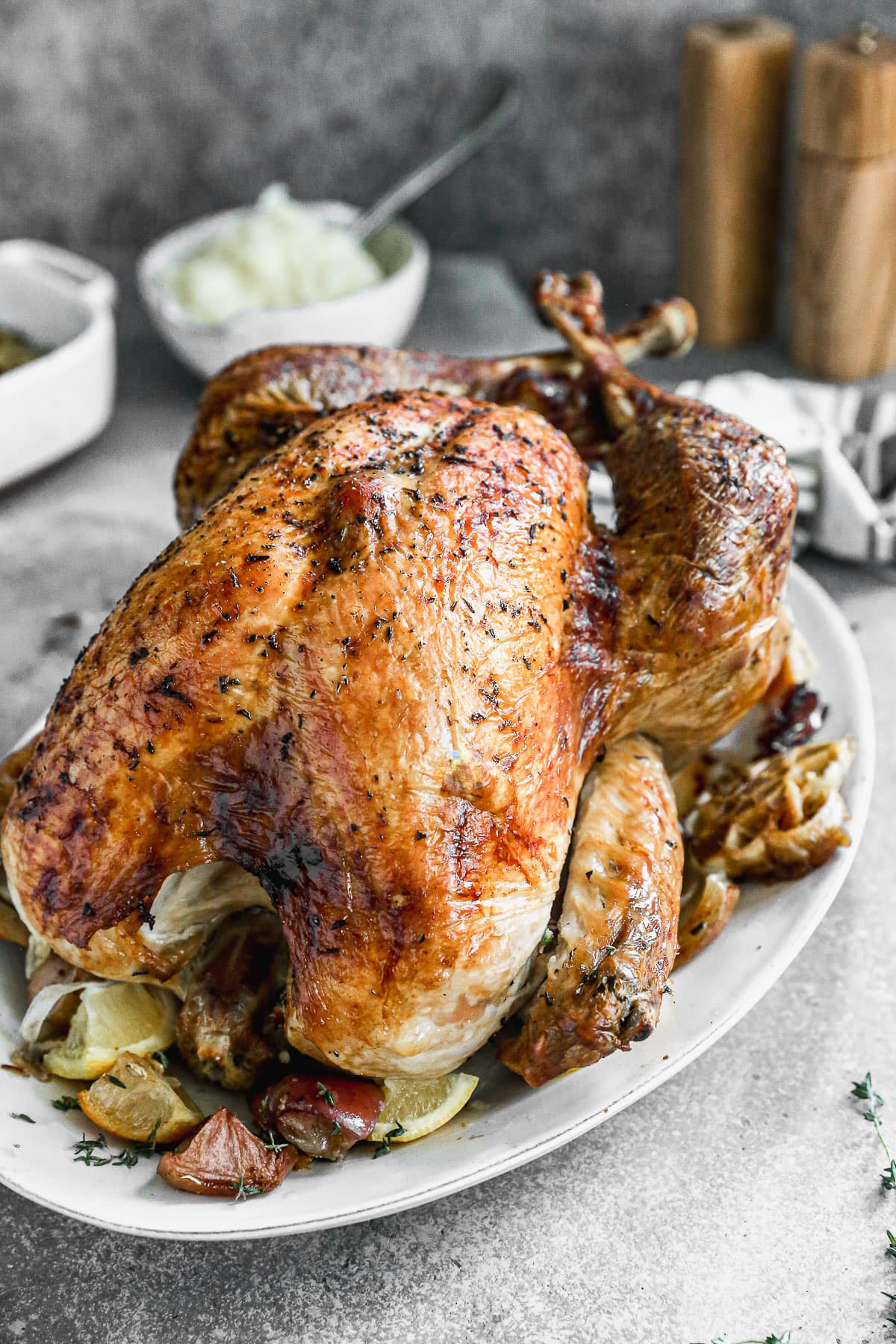THIS IS IT! The best Thanksgiving Turkey recipe. I’ve been roasting turkey for more than 15 years. This post combines the best of my learnings so you can master how to cook a turkey in the oven to be moist, succulent, and the star of your feast. It’s 100% doable and easier than you think!
As Thanksgiving approaches, home cooks everywhere are preparing for the big event – roasting the star of the show, the holiday turkey. One of the key decisions in cooking your turkey to perfection is whether to roast it covered or uncovered. There are good reasons for both methods, so which is best? Read on as we settle this age-old debate and provide tips for achieving the ideal golden brown, moist and flavorful turkey.
The Case for Cooking Turkey Covered
Cooking your turkey initially covered with aluminum foil has some major advantages
- Prevents drying out. Covering the turkey traps in steam and moisture as it cooks, keeping the meat much juicier than roasting uncovered from start to finish.
- Cooks evenly The foil allows the heat to circulate all around the turkey, preventing hot spots that lead to uneven cooking
- Self bastes. The sealed environment essentially steams the turkey in its own juices self basting it as it roasts for added flavor and tenderness.
- Saves prep time. No need to constantly baste the turkey or tent with foil to prevent over-browning when cooking covered. Set it and forget it (for a while).
For these reasons, most cooking experts recommend starting your turkey roasted covered with foil for at least the first half to two-thirds of the total cooking time.
The Case for Uncovered Turkey Roasting
However, cooking the turkey completely covered does have one major drawback:
- No crispy skin. Covering the turkey the entire time steams the skin and prevents it from browning and crisping as it would uncovered.
That’s why many recipes call for removing the foil for the last 30-60 minutes of roasting time. This crisps up the skin for picture-perfect presentation and added texture and flavor.
Cooking uncovered also allows you to:
- Brown the skin. The high heat will brown the turkey skin evenly, especially important for the paler breast meat.
- Thicken the juices. Uncovered roasting reduces the juices down for rich, concentrated gravy full of turkey flavor.
- Show off your bird. You worked hard on cooking this feast centerpiece. Let it shine in all its golden glory for your guests.
Combining Methods for the Best Results
Given the benefits to both covered and uncovered roasting, the best approach is to combine these methods:
- Start covered. Begin roasting your turkey completely covered in foil. This steams it initially for moist, tender meat.
- Finish uncovered. Remove foil for the last 30-60 minutes. This crisps the skin without overdrying the meat.
- Watch temps. Use a meat thermometer to ensure even doneness, especially in the thick breast meat.
- Shield if needed. If some areas seem to be browning too fast, lightly tent them with foil as needed near the end.
Turkey Roasting Tips for Golden, Juicy Results
Beyond choosing covered vs. uncovered roasting, here are some other tips for roasting the perfect turkey:
- Brine the bird. Soaking in a saltwater brine ensures seasoned, moist meat.
- Pat dry. Remove the turkey from the brine and pat very dry with paper towels for crisper skin.
- Rub with oil. Coat with oil or melted butter for even browning and richer flavor.
- ** Use a rack.** Place turkey on a rack in a roasting pan so air circulates all around.
- Cook breast down. Initially cooking breast-side down self-bastes the breast meat. Flip over later to brown.
- Make turkey tent. Loop foil loosely over the turkey to tent rather than sealing tightly.
- Let rest. Allow the turkey to rest 15-30 minutes before carving for juicy results.
With these handy tips, you can look forward to a flawless turkey with crisp, golden brown skin enveloping tender, succulent meat. Take the guesswork out of roasted turkey and relax and enjoy your holiday when you combine covered and uncovered cooking. What are you waiting for? Go get that foil and thermometer and soon you’ll have the Norman Rockwell-worthy bird of your dreams!

Checking Turkey for Doneness
The proper way to test your turkey for doneness is to insert an instant read thermometer into the thickest part of the breast and the inside part of the thigh.
- When checking the thigh, stay as close to the bone as possible without actually touching it.
- Make sure you are not poking through the skin all the way into the turkey cavity, which can cause your thermometer to register lower than the meat’s temperature.
- Do not use the pop out thermometers that come with some turkeys; they are not very accurate and you’ll overcook the turkey.
- A digital read thermometer like this one is inexpensive and well worth not ruining your turkey!

Add Liquid to the Pan
Pouring liquid into the roasting pan helps keep the turkey moist and gives you more juices to use for gravy or for serving at the end.
Do you cook a turkey covered or uncovered?
FAQ
Is it better to bake a turkey covered or uncovered?
Do you cook a turkey covered or uncovered Butterball?
Is it better to cook turkey at 325 or 350?
How long to leave turkey uncovered in oven?
